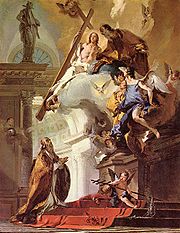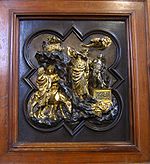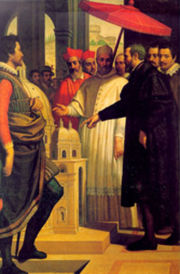
Modello
Encyclopedia

Tuscany
Tuscany is a region in Italy. It has an area of about 23,000 square kilometres and a population of about 3.75 million inhabitants. The regional capital is Florence ....
in the fourteenth century. Modern definitions in reference works vary somewhat. Alternative and overlapping terms are "oil sketch
Oil sketch
An Oil sketch or oil study is an artwork made primarily in oil paints that is more abbreviated in handling than a fully finished painting. Originally these were created as preparatory studies or modelli, especially so as to gain approval for the design of a larger commissioned painting...
" (schizzo) and "cartoon
Cartoon
A cartoon is a form of two-dimensional illustrated visual art. While the specific definition has changed over time, modern usage refers to a typically non-realistic or semi-realistic drawing or painting intended for satire, caricature, or humor, or to the artistic style of such works...
" for painting
Painting
Painting is the practice of applying paint, pigment, color or other medium to a surface . The application of the medium is commonly applied to the base with a brush but other objects can be used. In art, the term painting describes both the act and the result of the action. However, painting is...
s or stained glass
Stained glass
The term stained glass can refer to coloured glass as a material or to works produced from it. Throughout its thousand-year history, the term has been applied almost exclusively to the windows of churches and other significant buildings...
, maquette
Maquette
A maquette is a small scale model or rough draft of an unfinished architectural work or a sculpture...
, plastico or bozzetto for sculpture or architecture, or architectural model
Architectural model
An architectural model is a type of a scale model, tangible representation of a structure built to study aspects of an architectural design or to communicate design ideas to clients, committees, and the general public...
.
Though in Gothic figural arts bishops and abbots are often represented carrying small simulacra of buildings they had constructed— "models" in the familiar modern sense— modello is only used of pieces which pre-date the finished work, and were at least in part produced by the main artist involved. The less frequently found term ricordo (Italian for "record" or "memory") means a similar piece produced as a small copy after completion of the work as a record for the workshop. Naturally it is not always easy for art historians to decide whether a particular piece is one or the other, and, especially in the Late Renaissance and Baroque periods, when several versions of a painting were made, the ricordo for the prime version might serve in the atelier as the modello for the subsequent ones. No doubt a modello was often modified after the main work was completed to reflect any changes in the composition during painting, thus making it a ricordo also; this would normally be impossible for art historians to distinguish from a modello altered during its original production.
The Tiepolo
Giovanni Battista Tiepolo
Giovanni Battista Tiepolo , also known as Gianbattista or Giambattista Tiepolo, was an Italian painter and printmaker from the Republic of Venice...
at right was catalogued as a modello by Michael Levy, but recent x-ray
X-ray
X-radiation is a form of electromagnetic radiation. X-rays have a wavelength in the range of 0.01 to 10 nanometers, corresponding to frequencies in the range 30 petahertz to 30 exahertz and energies in the range 120 eV to 120 keV. They are shorter in wavelength than UV rays and longer than gamma...
investigation of the huge finished work in Munich has revealed that in its underpainting
Underpainting
In art, an underpainting is an initial layer of paint applied to a ground, which serves as a base for subsequent layers of paint. Underpaintings are often monochromatic and help to define colour values for later painting...
it was closer to another, very different and less finished modello, now in the Courtauld Institute, and it has been asserted that the National Gallery picture illustrated is a ricordo. The National Gallery still describe it as "probably a modello", presumably produced after work had already begun.

Italic type
In typography, italic type is a cursive typeface based on a stylized form of calligraphic handwriting. Owing to the influence from calligraphy, such typefaces often slant slightly to the right. Different glyph shapes from roman type are also usually used—another influence from calligraphy...
s, or not. The French version of the word, modèle, may be used of French works, and is normally italicised.
Especially in the case of oil sketches, many modelli are greatly valued in their own right, as they may show a freedom in execution and freshness of inspiration missing in the final work, and also may show changes in composition from the finished work, throwing light on the process of artistic creation. Earlier stages of the creative process may be recorded in "preparatory drawings" or "studies", either for the whole composition, or a part of it, such as a single figure.

Giorgio Vasari
Giorgio Vasari was an Italian painter, writer, historian, and architect, who is famous today for his biographies of Italian artists, considered the ideological foundation of art-historical writing.-Biography:...
's vita
Biography
A biography is a detailed description or account of someone's life. More than a list of basic facts , biography also portrays the subject's experience of those events...
of Rosso Fiorentino
Rosso Fiorentino
Giovanni Battista di Jacopo , known as Rosso Fiorentino , or Il Rosso, was an Italian Mannerist painter, in oil and fresco, belonging to the Florentine school.-Biography:...
: Vasari reports that a modello for Rosso's frescoes in Santa Maria delle Lagrime, Arezzo, was carried out by Rosso for Giovanni Pollastra, the inventor of the complex program there, "un bellisimo modello di tutto l'opera, che è oggi nelle nostre case di Arezzo." A preliminary modello colorito in the form of a painted three-dimensional model was especially important to prejudge the finished effect of illusionistic sotto-in-su perspectives on the curved surfaces of vaulted ceilings, as Andrea Pozzo
Andrea Pozzo
Andrea Pozzo was an Italian Jesuit Brother, Baroque painter and architect, decorator, stage designer, and art theoretician. He was best known for his grandiose frescoes using illusionistic technique called quadratura, in which architecture and fancy are intermixed...
, the perfector of the illusionistic ceiling, noted in his Perspectiva pictorum et architectorum (1700-17)
Many modelli show versions of works which were never actually realised, or have been lost. Famous examples are the alternative designs produced for the competition in 1401 to design the North doors of the Florence Baptistry. Lorenzo Ghiberti
Lorenzo Ghiberti
Lorenzo Ghiberti , born Lorenzo di Bartolo, was an Italian artist of the early Renaissance best known for works in sculpture and metalworking.-Early life:...
won, beating six other artists, including Filippo Brunelleschi
Filippo Brunelleschi
Filippo Brunelleschi was one of the foremost architects and engineers of the Italian Renaissance. He is perhaps most famous for inventing linear perspective and designing the dome of the Florence Cathedral, but his accomplishments also included bronze artwork, architecture , mathematics,...
, Donatello
Donatello
Donato di Niccolò di Betto Bardi , also known as Donatello, was an early Renaissance Italian artist and sculptor from Florence...
and Jacopo della Quercia
Jacopo della Quercia
Jacopo della Quercia was an Italian sculptor of the Italian Renaissance, a contemporary of Brunelleschi, Ghiberti and Donatello. He is considered a precursor of Michelangelo.-Biography:...
; the modelli survive, for a single panel, of the first two named (Bargello
Bargello
The Bargello, also known as the Bargello Palace or Palazzo del Popolo is a former barracks and prison, now an art museum, in Florence, Italy.-Terminology:...
- picture above).
There are alternative, unrealised, modelli for many famous buildings, including St Peter's, Rome and the "Great Model" of St Paul's Cathedral, London, showing a different design by Sir Christopher Wren from that actually built. When accepted, such models were retained during the work, as concrete expressions of what was expected under the terms of the contract, and afterwards were preserved in storage through salutary neglect.

